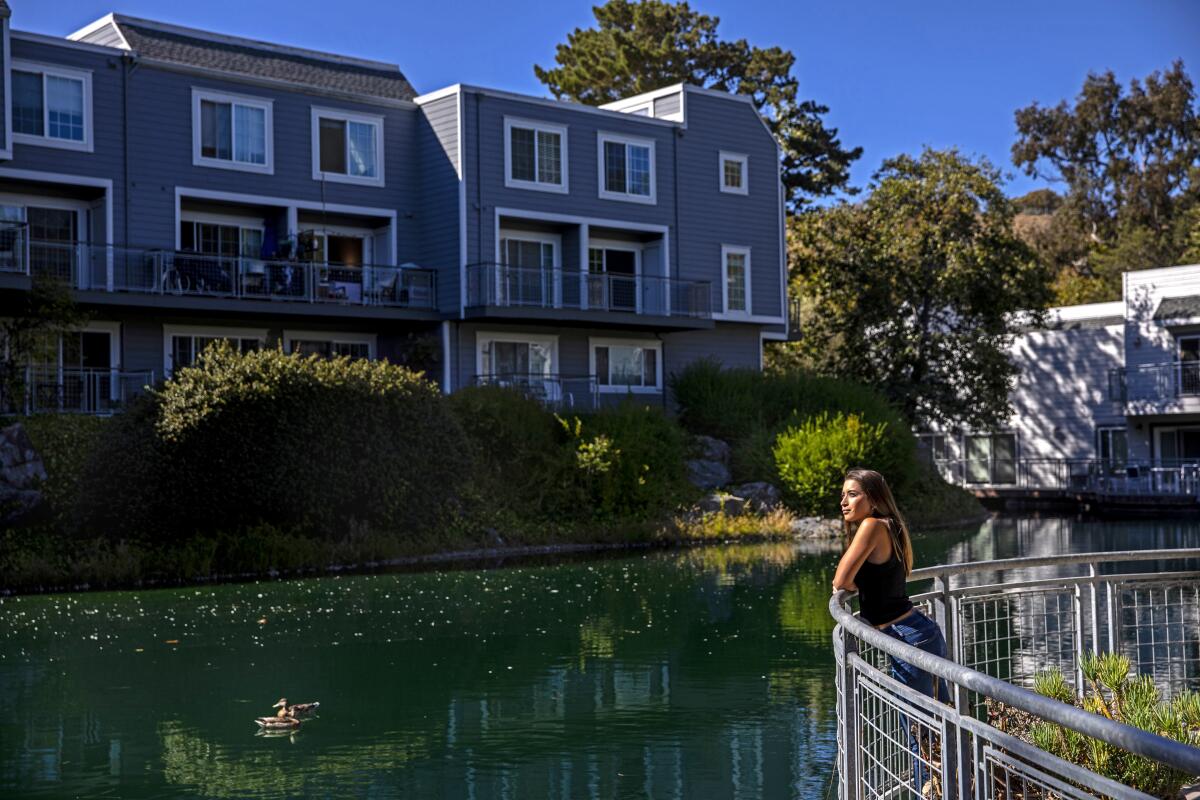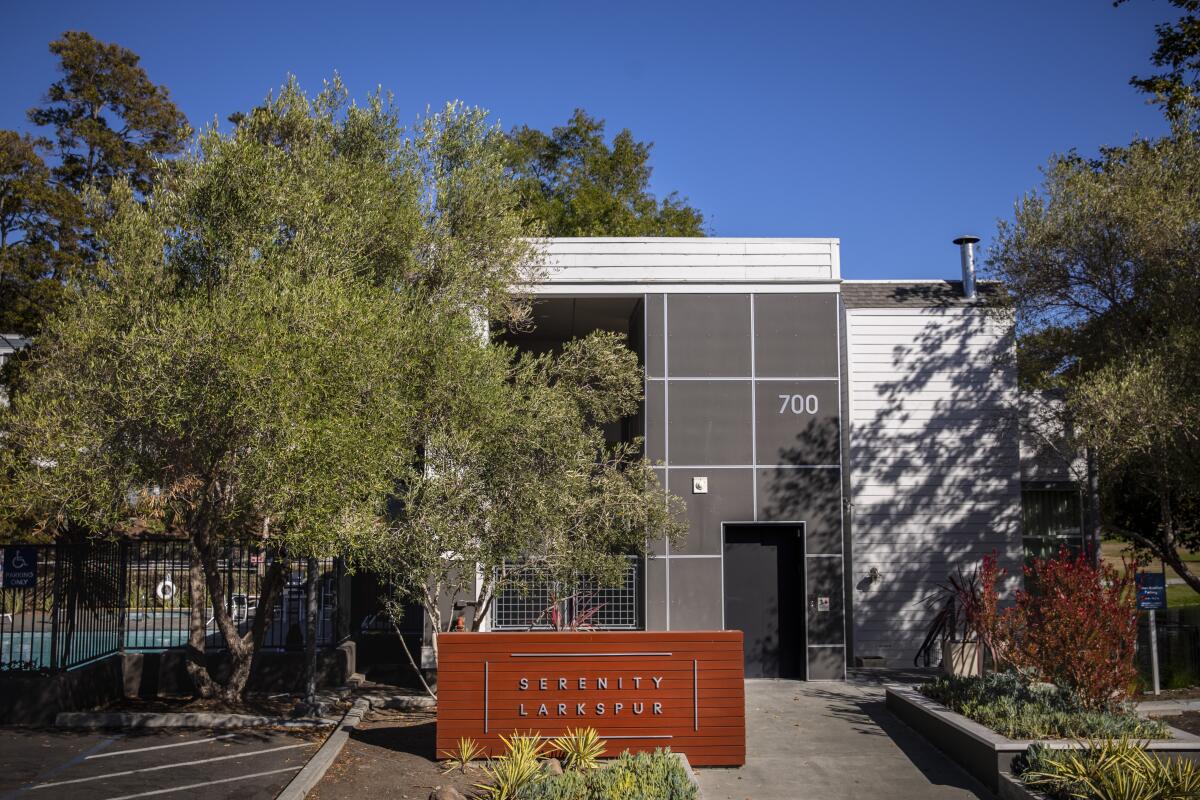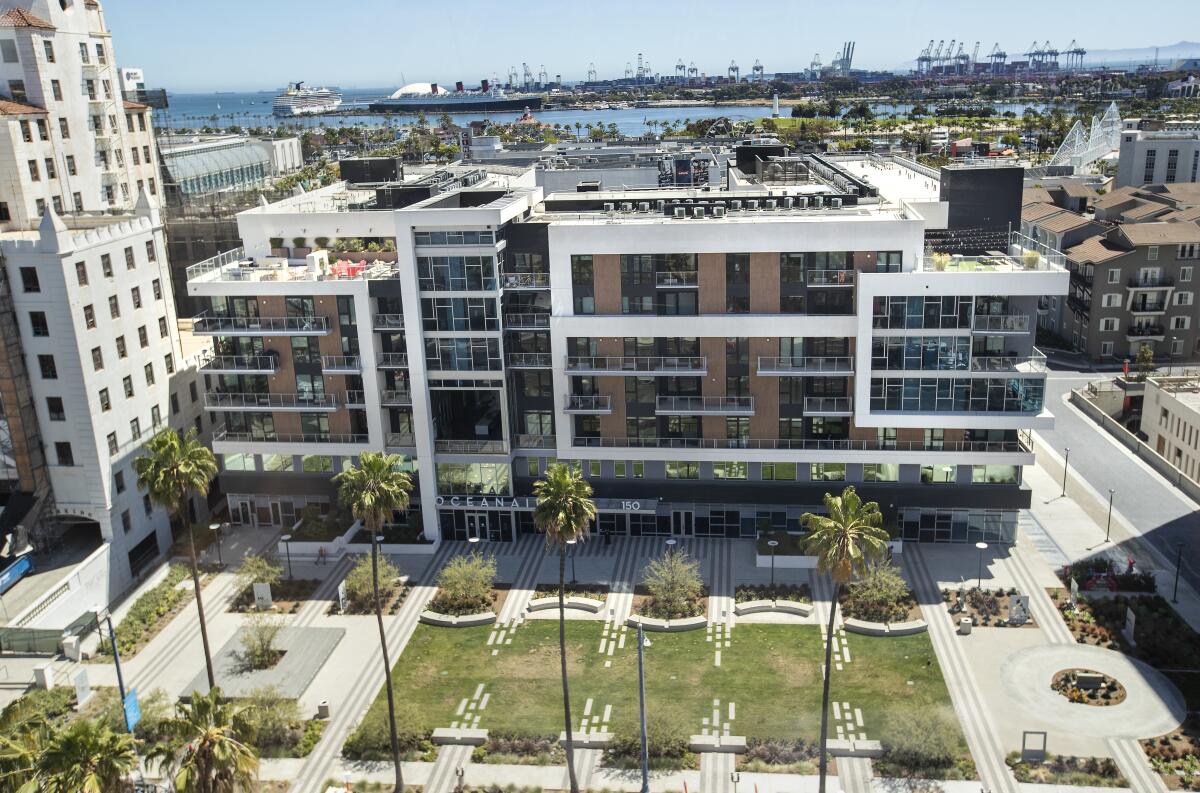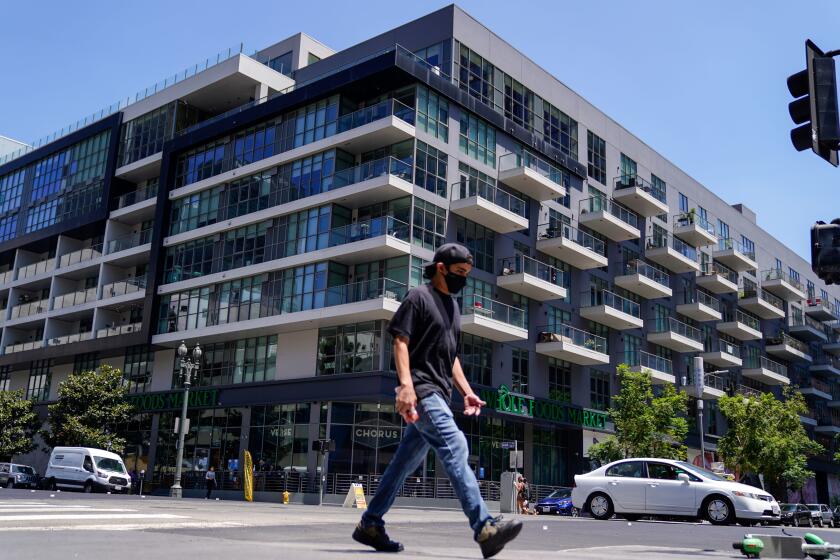Buy a luxury building, then lower the rent: A housing fix for California’s middle class?

- Share via
In hopes of plugging the state’s affordable housing shortage, some California government agencies are purchasing buildings, usually luxury ones, and doing the opposite of most real estate buyers. They’re lowering the rent.
The programs are geared toward middle-income workers — including police officers, teachers and nurses — who make too much to qualify for most traditional subsidized housing but still struggle to afford a place near their work, according to government authorities and the private partners involved.
They hinge on a unique financial model that involves local property tax subsidies. Proponents say the approach makes thousands of units across the state more accessible to those who aren’t high earners — serving the so-called “missing middle” excluded from other affordable housing programs and left behind by a runaway real estate market.
At least three government agencies have launched these programs, bringing rents down by double-digit percentages in places such as Long Beach and Pasadena . In all, the government agencies — known as joint powers authorities — have bought more than 20 buildings, totaling more than 6,000 units.
Questions remain about the long-term consequences and underlying economics — including whether the cities, which must approve the deals and help underwrite the rent reductions, will actually be repaid. Some also dispute whether the rent cuts are large enough to make the program worthwhile.
We want to make sure there is significant public benefit when we forgo property tax.
— Jacky Morales-Ferrand, city of San Jose housing department
The Los Angeles City Council is awaiting a staff report on the possibility of joining. In Northern California, the San Jose City Council declined to participate after city staff concluded “the risks and costs of joining ... outweigh the potential benefits.”
Despite such misgivings, the programs expanded quickly during the pandemic as rock-bottom interest rates made it easier to finance acquisitions and economic uncertainty meant fewer traditional property investors were competitors.
And for some renters able to afford housing that was previously out of reach, they have been game-changers.
“I am able to do my job better,” said René Maher, a fifth-grade teacher in Marin County, whose commute plunged from two hours to eight minutes when she moved into a subsidized development in the bayside town of Larkspur.

The most active authorities purchasing buildings are the California Statewide Communities Development Authority, or CSCDA, and the California Community Housing Agency, or CalCHA, which launched the first program in 2019.
Rent levels vary by income, but in properties they have purchased, building-wide rent declines have averaged about 10% from what the previous owner charged, with greater decreases seen for the lowest income units, according to Jon Penkower, a managing director at CSCDA, and Jordan Moss, founder of Catalyst Housing Group, the main private company working with CalCHA.
Moss said the reductions enable tenants to put more money away for savings, healthcare and education, and save time on long commutes.
Without a commute eating hours of her day, Maher, 25, said she’s able to spend more time with students, as well as work toward her goal of being an administrator.

She said she initially lived so far away from the school because closer apartments were rundown, in neighborhoods that felt unsafe or lacked appliances such as washers and dryers. Now she pays $1,779 for a one-bedroom apartment, on par with her previous one-bedroom, in a complex built in the ‘70s that includes two saltwater swimming pools, a yoga studio and clubhouse.
Her new neighborhood feels safe, and she can walk to the Marin Country Mart shopping center for drinks or the farmers market.
Local subsidies
The middle-income programs, as described by backers, are not simple real estate transactions.
Joint powers authorities, which issue and manage bonds on behalf of local governments that join as members, help fund the middle-income programs. They issue bonds and use the proceeds to purchase a property, as well as pay the private companies that arrange the financing and manage the buildings.
Because the authorities are government entities, they don’t need to pay property tax. Those savings are passed along to tenants in the form of lower rent, while the bonds entice investors with interest payments.
The bonds mature in around 30 years. Once they are paid off, proponents say the city can direct a sale of a property with no debt, or run the property and take out a loan on the buildings. The proceeds from either of those transactions goes to the city, which should mean the city receives more money than the property tax they lost out on, those involved in the programs say.
Cities can force a sale or refinance as soon as 15 years from the bonds’ issuance, though that would make it harder to get their money back.
Each project is different, but the joint powers authorities tend to serve households making the upper limits of what is considered low income to those making moderate incomes, with roughly an equal amount of apartments reserved for each income bracket.
To move in, tenants must apply and verify their incomes are within the required bracket.

Tenants who make more and lived in the property before an acquisition by an agency aren’t evicted and can renew their leases to stay as long as they want, authorities said. Once they do leave, those units become income-restricted.
In some cases, after a building acquisition, rent for some units at the upper income limits hasn’t dropped and market rate is being charged, but backers say that over time limitations on rent increases embedded in the programs mean those units should become cheaper than they otherwise would have been.
At times, the programs have also provided subsidized housing for people who could qualify for traditional low-income housing projects, based on their income related to the cost of living in their area. In pricey Marin County, that includes teacher Maher, who benefited from both the typical rent declines from the program subsidy, as well as a special teacher subsidy offered by Catalyst.
For lower- and middle-income renters who move in, the perks of luxury-apartment life are immediately clear in buildings such as Oceanaire, a 216-unit complex in downtown Long Beach, one of six projects that Waterford Property Co., a private real estate investment firm, runs for CSCDA.
On nearly two acres of prime downtown land, there’s a resident clubhouse with chilled wine dispensers and a 24-hour fitness center that overlooks a swimming pool.

In the first-floor courtyard, residents can lounge on couches positioned on walkways that jut out like peninsulas into a large shallow pond meant to invoke the Indonesian island of Bali.
Inside, apartments boast 10-foot ceilings, quartz countertops and expansive balconies.
Before CSCDA purchased the building in March, it cost $2,592 a month for a one-bedroom unit and $3,569 for a two-bedroom, according to bond documents. Now, a two-person household earning $75,680 or less — the lowest income bracket served at Oceanaire — would pay $2,102 for a one-bedroom and $2,366 for a two bedroom, declines of 19% and 34%, respectively.
“That is something that is badly needed,” Waterford co-founder John Drachman said.
Millions of Americans, especially low-income tenants, are accumulating debt amid the COVID-19 pandemic, threatening to create a downward financial spiral.
Still, cheaper rent can be found in many of the cities where the programs operate, raising scrutiny of the affordability the program administrators are marketing.
In Long Beach, the median rent for a one-bedroom was $1,481 in July, according to listings site Apartment List — $621 less than the cheapest one-bedroom unit at Oceanaire, and $1,111 less than the one-bedrooms reserved for those in the highest allowable income bracket.
“Why should we collectively spend ... to create another apartment that’s not even cheaper than what they can get on the existing market?” said Matt Schwartz, chief executive of the California Housing Partnership, a nonprofit that advocates for subsidized housing and consults affordable housing providers.
The partnership analyzed the rent prices CalCHA and CSCDA told bond investors they would charge, and compared them to the average local rents. In most cases, the analysis found that the new rent, even when reduced, was higher than the citywide average for an apartment with the same number of bedrooms.
Schwartz said the analysis suggests many people renting through the programs could find cheaper housing not funded through public subsidy that could otherwise go toward schools, police and other services. He added that the higher quality of homes on offer is “nice, but it shouldn’t be the standard for using public funds in our view.”
How affordable?
Concerns over levels of affordability have also surfaced in some city deliberations. Before Long Beach approved the Oceanaire deal, the city hired HR&A Advisors, a real estate consulting firm, to analyze the proposed transaction.
In a report to city staff, the consulting firm said that after its initial analysis was shared with CSCDA and Waterford, the project manager, the pair agreed to offer more units for those in the lowest income category served by the programs — raising the lowest income share to 40% of units, from the 33% typically offered in the programs.
HR&A still painted a critical portrait of the program after those changes, including over compensation paid to CSCDA and Waterford that it considered excessive and ate into how much rent could be reduced.
In its own memo to council, city staff said that given market fluctuations “there are likely situations where the city and other taxing bodies do not recover foregone property tax or make a profit.”
Staff recommended council members approve the Oceanaire deal but treat it as a pilot and agree not to approve similar projects until the council had time to consider an overarching policy governing such programs.
In a 9-0 vote in February, the council approved that recommendation, and the deal went through.
Is this the perfect tool for solving moderate income housing? No, but is it a tool? Absolutely.
— Sean Rawson, Waterford co-founder
The San Jose City Council decided the opposite. In May, it voted 11 to 0 to not join any of the established programs after staff raised concerns over loss of property tax revenue, lack of city oversight and how compensation paid to project participants limited affordability to levels it considered “modest.” Though rent is sometimes reduced further, staff singled out the fact that the authorities have capped rent at 35% of area median income, rather than limiting it at the traditional measure of affordability, 30%.
At the upper-income levels, staff wrote, some rent is “essentially market-rate.”
“It’s definitely creative,” Jacky Morales-Ferrand, director of the city’s housing department, said of the programs. “But we want to make sure there is significant public benefit when we forgo property tax.”

The government authorities and private real estate companies said the upper-income units help offset larger declines at the lower brackets, and they defended their fees as reasonable, in line with other affordable housing projects and justified in terms of ongoing management they provide and risk they take in lining up potential deals that might fall through.
“Prior to the close of escrow, the [private firms like Waterford] typically risk $3 [million] to $5 million per deal via pursuit costs that can be lost if the transaction does not close,” Penkower wrote in a rebuttal to San Jose.
Moss, who similarly defended his company’s fees, said that although some of the criticism was unfair, the company has taken some of it to heart and is now capping rent at 30% of area median income, including two projects in Huntington Beach completed with the California Municipal Finance Authority.
The Southern California median home prices rose 17% to a record high in July, though there are some signs the market is cooling.
Given the historical rise in real estate values, program backers said it’s unlikely a city would not get more tax revenue back than it deferred after it sold the building or kept it and took out a loan on the property.
They also criticized the idea that rent at their properties should be compared to a citywide average. Rather, they said the correct comparison was to look at how rent in their buildings differs from rent in similar-quality buildings in the same neighborhood.
Carol Galante, founder of the Terner Center for Housing Innovation at UC Berkeley, said making high-quality apartment communities more affordable — even if they are still more expensive than many older units nearby — could have knock-on benefits. It could encourage middle-income households to move out of older units, freeing those up for people of lower incomes.
With California’s economy reopening, rent in Los Angeles and other big cities is beginning to rise.
The programs institute limits on future rent increases that are stricter than state law. Galante and others said it’s important to consider what might have happened absent an acquisition by the authorities: private investors could have swooped in during the economic recovery and jacked up rents.
Already, landlords across the country are finding they again have power to raise rents aggressively.
Waterford’s Drachman said his company — even in the higher-income brackets — always provides a discount to what market rate would be at the property. And reducing rent at marquee buildings ensures fewer teachers, paramedics and others will leave their communities in search of a place to live that’s not only affordable but also comfortable.

“Yes, there are cheaper apartments in the city of Long Beach, but they are nowhere near the quality of Oceanaire,” Drachman said. “If you are someone who makes less income ... that person shouldn’t have to sacrifice quality.”
Oceanaire is not just a luxury complex. It’s less than half a mile from the A Line train to downtown Los Angeles, as well as the Pike Outlets shopping center and the Aquarium of the Pacific, a popular tourist attraction with roughly 1.5 million visitors a year.
Tenants who lived there under the previous owner and make too much to qualify under the new income limits can renew their leases, as they can in other program buildings. But unlike those properties, Drachman said Waterford must charge these wealthier tenants a 7% increase upon renewal, a requirement the city wanted to ensure the units turned over quicker.
Occupancy has grown since CSCDA acquired the buildings, to 96% from 70%, Drachman said. Recent lease-signers include law enforcement officers, city employees and a medical technician.
Sean Rawson, Waterford’s other co-founder, said: “What you can quantify here is that we are passing along significant rental savings to our tenants. Is this the perfect tool for solving moderate-income housing? No, but is it a tool? Absolutely.”
Victoria Dries and her wife, Nicky, were on their way out of California, to Pennsylvania, when a subsidized apartment at Oceanaire surfaced and had them reconsider.
Dries, an art teacher, and Nicky, who works in school administration, faced a rent bump on their downtown Long Beach one-bedroom, to about $2,650 a month, that would have strained their budget. Rather than downsize or move into a more rundown place, they planned to move to Pittsburgh “where everything is cheaper” and Dries has family.
“We had already paid for the movers to come get our stuff,” Dries said. Then they found a $2,366 two-bedroom unit at Oceanaire and jumped at the chance to stay. “And when we got in here we just canceled everything.”
More to Read
Inside the business of entertainment
The Wide Shot brings you news, analysis and insights on everything from streaming wars to production — and what it all means for the future.
You may occasionally receive promotional content from the Los Angeles Times.














